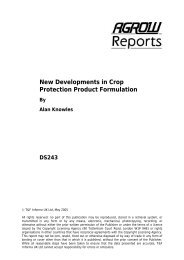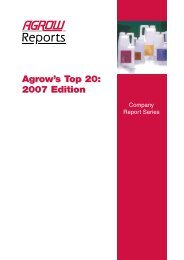BASF ups new ais and pipeline sales potential - Agrow
BASF ups new ais and pipeline sales potential - Agrow
BASF ups new ais and pipeline sales potential - Agrow
- TAGS
- basf
- pipeline
- agrow
- www.agrow.com
Create successful ePaper yourself
Turn your PDF publications into a flip-book with our unique Google optimized e-Paper software.
AGROW | No 633 | February 8th 2012 Products<br />
Bayer debuts fluopyram in Turkey<br />
Bayer CropScience has debuted a fungicide formulation based<br />
on its <strong>new</strong> active ingredient, fluopyram, in Turkey. The country<br />
granted registration late last year, <strong>and</strong> it is the first confirmed<br />
product approval for a fungicide based on the active ingredient.<br />
Luna Experience (fluopyram 200 g/litre + tebuconazole 200<br />
g/litre) is a suspension concentrate formulation for use on<br />
nine crops, including apples for the control of scab (Venturia<br />
inaequalis), on grapevines against powdery mildew (Uncinula<br />
necator), cherries against brown rot (Monilinia laxa), <strong>and</strong><br />
tomatoes, aubergines <strong>and</strong> peppers for the control of tomato<br />
powdery mildew (Leveillula taurica). It is safe for bees <strong>and</strong> nontarget<br />
organisms, Bayer notes.<br />
Fluopyram comes from the pyridylethylbenzamide family of<br />
fungicides. It is a succinate dehydrogenase inhibitor (SDHI).<br />
Fluopyram was developed for use on over 70 crops, <strong>and</strong> was<br />
unveiled in 2009 (<strong>Agrow</strong> No 567, p 23). Recommended<br />
application rates for the ai range from 0.2-0.5 litres/ha.<br />
The US EPA has recently proposed the registration of five<br />
fungicide products based on fluopyram, some in formulation<br />
with other <strong>ais</strong>, including Luna Experience (<strong>Agrow</strong> No 631, p<br />
20). The EU registration application for the <strong>new</strong> fungicide was<br />
declared complete in 2009, <strong>and</strong> first member state approvals<br />
were expected by 2011 for use on grapevines <strong>and</strong> strawberries<br />
(<strong>Agrow</strong> No 567, p 23).<br />
<strong>BASF</strong> br<strong>and</strong>s <strong>new</strong> dicamba<br />
Engenia<br />
<strong>BASF</strong> plans to apply for US approval for a <strong>new</strong> formulation of<br />
the herbicide, dicamba, under the Engenia br<strong>and</strong> this year. It is<br />
intended for use on Monsanto’s genetically modified dicambatolerant<br />
soybeans. “Engenia will be an important <strong>new</strong> tool for<br />
soybean growers battling herbicide-resistant weeds, like Palmer<br />
amaranth, waterhemp [both Amaranthus spp] <strong>and</strong> marestail<br />
[Conyza canadensis],” says Paul Rea, vice-president of <strong>BASF</strong>’s<br />
US crop protection business. Research on advances in dicamba<br />
formulations <strong>and</strong> the use of the herbicide on dicamba-tolerant<br />
crops was presented at the US Southern Weed Science Society<br />
annual meeting last month.<br />
<strong>BASF</strong> <strong>and</strong> Monsanto have been collaborating on the<br />
development of dicamba formulations for use on GM soybeans<br />
for the past three years. The companies entered into a licensing<br />
agreement covering the commercialisation of the herbicides last<br />
year (<strong>Agrow</strong> No 612, p 2).<br />
<strong>BASF</strong> expects to receive US approval for Engenia prior to the<br />
commercialisation of Monsanto’s Genuity Roundup Ready 2<br />
Yield dicamba-tolerant soybeans. Its first stacks of dicamba<br />
tolerance <strong>and</strong> glyphosate tolerance are being lined up for<br />
on-farm testing in 2013, with a commercial launch planned<br />
for 2014 (<strong>Agrow</strong> No 631, p 4). Monsanto is also developing<br />
dicamba-tolerant cotton, maize <strong>and</strong> canola.<br />
JANUARY 2011<br />
The US Patent <strong>and</strong> Trademark Office in December published<br />
a total of 53 patent applications from 28 different assignees,<br />
covering genetically modified plants <strong>and</strong> methods of producing<br />
them.<br />
Two were for input traits, one of which, from Bayer<br />
CropScience, concerned a chimeric gene construct conferring<br />
resistance to several different classes of herbicides. There were<br />
27 applications published that concerned output traits, including<br />
15 claiming improvements to stress tolerance or increasing<br />
yield. Methods of altering the content of GM plants accounted<br />
for nine applications. These included a pair of filings from <strong>BASF</strong><br />
concerning the production of arachidonic <strong>and</strong> eicosapentaenoic<br />
acid in plants using desaturase enzymes derived from algae.<br />
Three applications concerned methods of altering plant<br />
phenotypes.<br />
A further 24 applications concerned other aspects of<br />
biotechnology, such as <strong>new</strong>ly identified promoters, expressed<br />
sequence tags or transformation methods. The latter included<br />
two filings from Dow AgroSciences for nanoparticle-mediated<br />
transformation methods.<br />
DuPont, including seed subsidiary Pioneer Hi-Bred<br />
International, dominated the field with 15 applications published.<br />
Its closest rival was Monsanto, which had six filings published.<br />
<strong>BASF</strong>, Ceres <strong>and</strong> Dow each had three applications published.<br />
Bayer <strong>and</strong> the US Michigan State University each had two<br />
applications published.<br />
To browse the complete list of selected patents, please log in at:<br />
http://www.agrow.com/plantbiotech/patentwatch.<br />
For enquiries, please email the Plant Biotech editor,<br />
Hazel Blake, at hazel.blake@informa.com.<br />
©Informa UK Ltd 2012 www.agrow.com 21<br />
10<br />
9<br />
8<br />
7<br />
6<br />
5<br />
4<br />
3<br />
2<br />
1<br />
0<br />
USPTO Patent Applications<br />
January 2012<br />
Herbicide Tolerance<br />
Insect Resistance<br />
Stacked<br />
Nematode resistance<br />
Other Pathogen Resistance<br />
Altered Content<br />
Altered Phenotype<br />
Stress/Yield<br />
Regulatory Sequences<br />
Transformation Methods<br />
Other Polynucleotide<br />
Sequences





